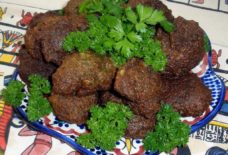Kefta--The Enhanced Middle Eastern Hamburger
By: Blanche Shaheen/Arab America Contributing Writer
Kefta elevates average ground meat to a completely different level of flavor, through the addition of extra herbs, spices, and aromatics. There are a variety of different names for this delicacy from kofta, kufta, kafteh, or keftes. This method of seasoning meat is hugely popular in the Middle East, where you will find it shaped into meatballs or cylinders of meat that can be cooked in a wide variety of ways. You can find kefta from street vendors where they sell kefta and pita sandwiches (otherwise known as arayes), or in restaurants where they may also be served as appetizers or as a more central part of a meal alongside rice and vegetables. While kefta is ubiquitous in the Levant countries of Lebanon, Palestine, Syria, and Jordan, you can also find this dish in Iran, Greece, India, North Africa, and even in Eastern Europe.
This dish is surprisingly easy to make at home where you can also adjust the spices to fit your tastes, and the possibilities are endless. Beef and lamb are two common choices of meat for kefta, or even a combination of both. Fortunately, lean meat is a better option, so that the kefta do not become too greasy upon cooking. You can get creative with herbs and aromatics like parsley, mint, garlic, onions, or even shallots. As far as spices, the recipe below keeps things simple with allspice as a foundation, but you can expand the flavor with cumin, coriander, sumac, and turmeric, or even a seven-spice mix. If you are on a budget and want to stretch out the meat, you can also blend the meat with rice, vegetables, or even bulgur wheat.
Once you combine the meat mixture, you can then grill, roast, bake, broil, boil, fry, or even steam the kefta. Some great condiments to serve alongside the meat are cucumber yogurt sauce, tahini sauce, or even hummus. Sides such as bread, rice or vegetables often accompany kefta, which may be molded on sticks so that they can be eaten easily, or wrapped into various breads to make sandwiches
If you want to shape the kefta into meatballs as a party appetizer, try making the pomegranate molasses glaze below, which you can brush onto the meatballs before serving as a Middle Eastern style barbeque sauce. This will give the meatballs a beautiful glaze and mildly sweet flavor.
Kefta Ingredients:
1 pound hamburger (can use ground lamb, beef, or a combination of both)
1/3 bunch parsley
1 clove garlic
½ small onion
Salt to taste
½ tsp lemon pepper
1 tsp allspice
Olive oil
Pomegranate Molasses Glaze
1 tbsp Balsamic Glaze 1 tbsp Pomegranate Molasses
1 tbsp Honey 1/4 cup olive oil
1 clove Black Garlic or regular garlic
Whirl the garlic, parsley, and onion in a food processor. By hand, gently incorporate the herb and vegetable mix with ground meat, salt, lemon pepper, and allspice. Shape the meat into long ovals on each skewer if you are broiling in the oven. If you are pan-frying this you can shape them into patties or meatballs. Brush the meat with olive oil before broiling or grilling. Broil or grill the kefta for about 5 minutes on each side. If pan-frying as meatballs or burger-style patties, melt 1 tbsp butter in a skillet on medium heat. Place the kefta in the well-heated pan. Don’t flip, touch, poke, or prod the kefta and let it sizzle for 3-4 minutes. The bottom of the burger’s edge should look cooked, while the top half should still look raw. Flip the kefta and cook an additional 2-3 minutes. If using a thermometer to measure the burger’s internal temperature, cook to a safe 160 degrees Fahrenheit, 140 degrees as a minimum. If making meatballs, prepare the glaze. In a food processor, add garlic, balsamic glaze, honey, olive oil, and pomegranate molasses. Whirl in a food processor until smooth. Once the meatballs are done, brush with the glaze before serving.
Blanche Shaheen is the author of the cookbook called “Feast In the Middle East, a Journey of Family and Cuisine” which you can order here: https://secure.mybookorders.com/mbo_index.php?isbn=9781545675113 She is also a journalist, and host of the popular cooking show called Feast in the Middle East. She specializes in Arab cuisine of the Levant and beyond. You can check out her cooking video tutorials at https://www.youtube.com/user/blanchetv Her recipes can also be found at https://feastinthemiddleeast.wordpress.com/
Visit Arab America’s blog here!









